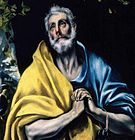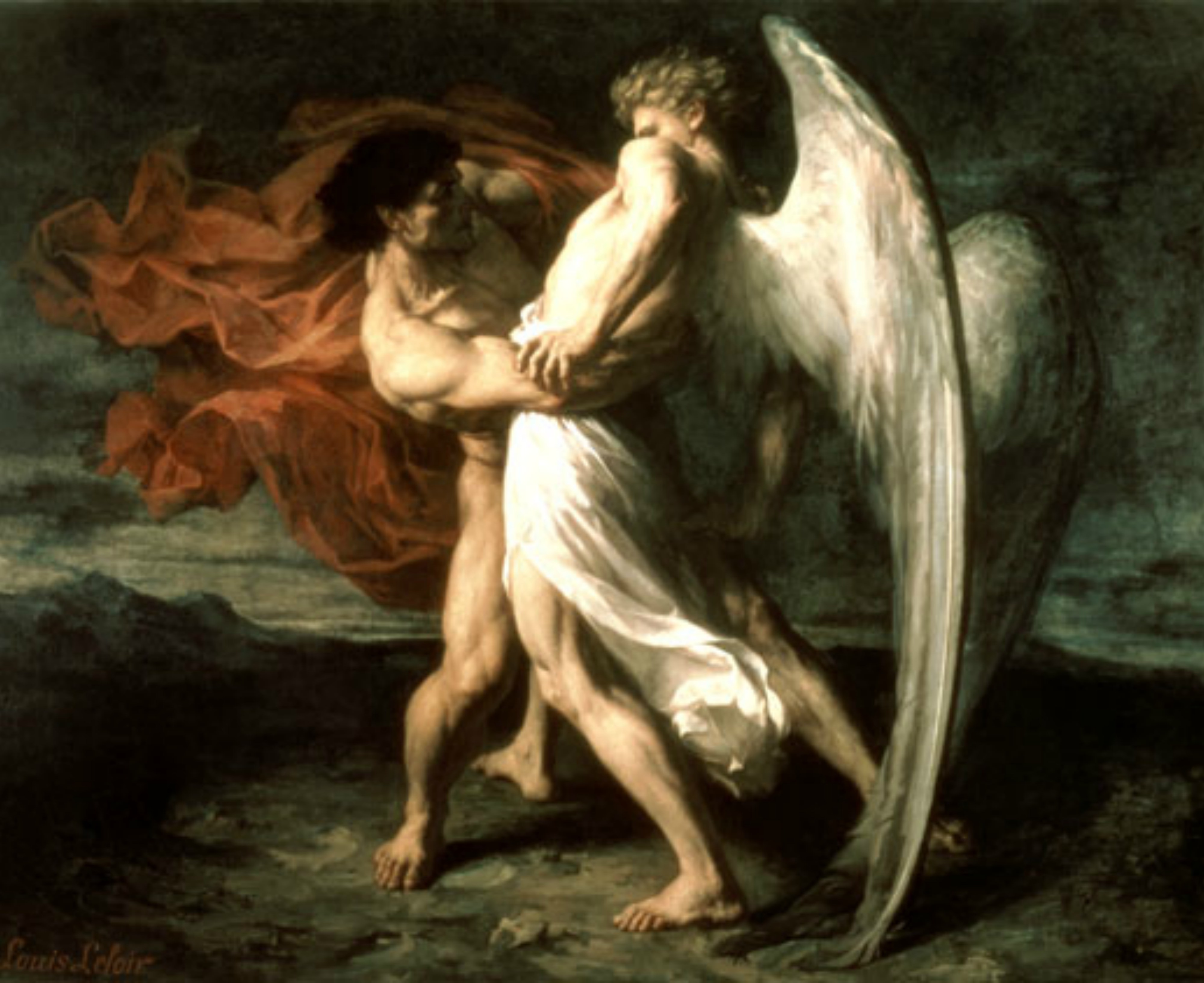
About Peter denying Jesus: Next Sunday’s Gospel – April 10 – tells how he got “restored to grace…”
* * * *
 Here’s a heads up: The Gospel for the Third Sunday of Easter is all about the Restoration of Peter. (Peter – who became a saint – is seen at right.) That is, in John 21:1-19, “Jesus restored Peter to fellowship after Peter had previously denied him.” (Not just once, but three times.)
Here’s a heads up: The Gospel for the Third Sunday of Easter is all about the Restoration of Peter. (Peter – who became a saint – is seen at right.) That is, in John 21:1-19, “Jesus restored Peter to fellowship after Peter had previously denied him.” (Not just once, but three times.)
But Jesus did more than that.
He specifically charged Peter to “feed my sheep.”
Note also that this express restoration of Peter – by Jesus – is unique to John’s Gospel:
All four gospels record Peter’s denial of Jesus, and all of the synoptic gospels record how Peter “wept bitterly” after the rooster crowed. John omits this detail [about Peter weeping bitterly], but he is unique in describing the restoration scene between Jesus and Peter.
All of which reminds us that Jesus is willing to do the same thing for us today. That is, He’s willing to forgive and forget – referring to us – for all the times in the past that we’ve disappointed Him. (Or “fallen short.” See Romans 3:23.) Just like He did with Peter.
For more on the shortcoming itself, see Denial of Peter. The article noted that the “emotional turmoil and turbulent emotions behind Peter’s denial and later repentance have been the subject of major works of art for centuries.” For example, in the painting at the top of the page (by Gerard van Honthorst): “A young maidservant accused the apostle Peter, in the yellow cloak, of knowing Jesus Christ. Fearing for his own safety, Peter denied the acquaintance…”
So much for the Bible readings coming up next Sunday, April 10. (See also the notes…)
 As for last Sunday (April 3), the Second Sunday of Easter (or the Sunday after Easter) is also – and always – “Doubting Thomas Sunday.” (He’s shown at left, with Jesus.)
As for last Sunday (April 3), the Second Sunday of Easter (or the Sunday after Easter) is also – and always – “Doubting Thomas Sunday.” (He’s shown at left, with Jesus.)
That’s because the Gospel for the day is always John 20:19-31. It tells about how Doubting Thomas got his name. (And in turn how his name became a byword for any and every “skeptic who refuses to believe without direct personal experience.”)
One of the first posts I ever did for this blog was First musings – The readings for “Doubting Thomas” Sunday. That post noted the term was “a reference to the Apostle Thomas, who refused to believe that the resurrected Jesus had appeared to the ten other apostles, until he could see and feel the wounds received by Jesus on the cross.”
Which brings up the spiritual questions raised by Thomas and his “doubting.”
First of all: “If you doubt and question your faith will it become stronger?”
In other words, how do we as Christians deal with our doubts? About the Bible and about the life of Jesus? Put another way: “The flip side of that [first] question is: ‘Should we just blindly believe?'” For boot-camp Christians the answer is simple: You shouldn’t have any doubts.
In other words, you should “blindly believe.” But for the rest of us – the ones who don’t want to stay Bible buck privates the rest of our lives – the best answer was noted in First musings:
Remember Thomas, the disciple, who wouldn’t believe in Christ’s resurrection until he put his hand into Jesus’s wounds. He went on to die spreading the gospel in Persia and India. God gave us free choice, He doesn’t want us to be robots, He could have made us like that, but wanted us to choose for ourselves. You learn and grow by questioning. (E.A.)
 That – to me – was the best answer. And for more on that idea – and position – see On arguing with God. That post noted that Jacob got his name changed to Israel precisely because he wrestled with God.
That – to me – was the best answer. And for more on that idea – and position – see On arguing with God. That post noted that Jacob got his name changed to Israel precisely because he wrestled with God.
And so he became “Patriarch of the Israelites.”
I also wrote about Thomas in Doubting Thomas’ “passage to India.” Among other things, that post noted the key difference between “skeptical” and “cynical.” The difference?
Being skeptical means “having reservations,” while the “main meaning of cynical is ‘believing the worst of people.” (Or, being “distrustful of human sincerity or integrity.”) On the other hand, the Bible itself tells us to approach the Faith with the proper sense of “reservation:”
Dear friends, do not believe every spirit, but test the spirits to see whether they are from God, because many false prophets have gone out into the world.
See 1st John 4:1, emphasis added. See also About Saint Thomas the Apostle.
That site said that after the Ascension of Jesus, the Apostles as a group decided who would go where, and for what missionary purpose. And those disciples told Thomas to go to India.
He objected, saying he wasn’t healthy enough for such travel, and that “a Hebrew couldn’t possibly teach the Indians.” Then too – like Saint Patrick – he became a literal slave:
A merchant eventually sold Thomas into slavery in India. It was then, when he was freed from bondage that this saint began to form Christian parishes and building churches… Thomas built a total of seven churches in India[. He is] an example of both doubter and a staunch and loyal believer… After all, each of us has both of these characteristics residing deep within ourselves – both moments of doubt and those of great spiritual strength…
Indeed, you might say that developing such “great spiritual strength” is only possible by having – and overcoming – those “moments of doubt.” (See also resistance training.)
And finally, a note about two recent Daily Office Readings of interest.
The first is the New Testament reading for Thursday, April 8, 1st Peter 2:11-25. That included 1st Peter 2:13 and 14: “Submit yourselves for the Lord’s sake to every human authority: whether to the emperor, as the supreme authority, or to governors, who are sent by him to punish those who do wrong and to commend those who do right.”
For more on that thought – especially appropriate in this season of politics – see On dissin’ the Prez. Which noted Acts 23:5: “Thou shalt not speak evil of the ruler of thy people.”
And finally there’s the Gospel for today, April 9, which includes John 16:12, where Jesus said: “I have much to say to you, but you are not able to grasp it now.” Which of course supports my theory that it doesn’t pay – spiritually – to be a “boot-camp Christian.”
In the meantime, we remembered Thomas – doubts and all – from last Sunday. And this Sunday we remember Peter, who first denied Jesus three times, then got “restored to grace…”
* * * *
Christ’s Charge to Peter, in which Jesus is both “forgiving and stern…”
* * * *
The upper image is courtesy of the link Denial of Peter, in Restoration of Peter – Wikipedia, the free encyclopedia. The full caption: “The Denial of St. Peter by Gerard van Honthorst (1622-24).” The description of the painting is courtesy of The Denial of St. Peter – ArtsConnectEd.
For more on forgiving and forgetting, see Does the Bible instruct us to forgive and forget?
The four readings for the Third Sunday of Easter – April 10 – are: Acts 9:1-6, (7-20), Psalm 30, Revelation 5:11-14, and John 21:1-19.
For more on St.Thomas in this post, see On St. Nick and “Doubting Thomas.”
The lower image is courtesy of Restoration of Peter – Wikipedia. The caption: “Christ’s Charge to Peter,” by Peter Paul Rubens (circa 1616). As to the forgiving and stern: “Paul Barnett notes that Jesus’ approach to Peter in John 21 is ‘both forgiving and stern.'”
